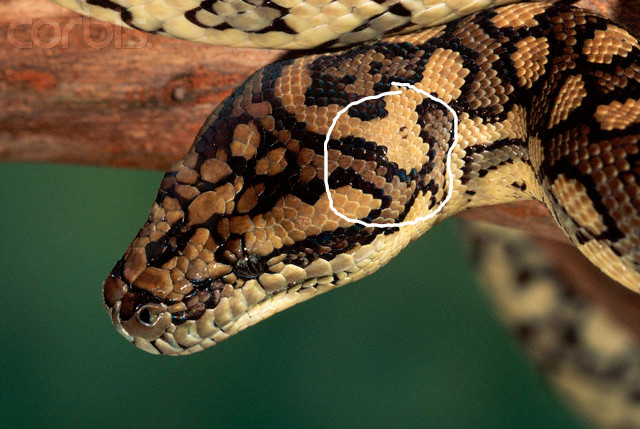user 29560
Not so new Member
- Joined
- Jul 18, 2011
- Messages
- 85
- Reaction score
- 0
Hey guys, this is just a personal interest question, but I'm having an unusually hard time finding an answer to it using my generally adept googling skills. I'm sure there must be some amateur (and even professional) herpatologists here.
While I like snakes in general, I'm particularly fond of pythons and specifically I am most interested in the Morelia genus. A physical trait of the Morelia snakes that I find very distinct and which attracted me to them is the shaping of the head and how it contrasts more starkly with the neck than in other species. For lack of better terminology, the back of the snake's head appears larger and more pronounced, as though it has larger/stronger muscles in the back of its jaws for greater bite strength. I've included a carpet python photo from google which I drew a circle to illustrate the area I'm referring to.
Can anyone more educated than myself provide me with more technical descriptions of the parts of a snake's head? I've been able to find the correct names of the various scales around the mouth (super-labial, sub-labial, etc), but the rest of the anatomy specifically related to the head has been very hard to track down and I usually end up getting all of the body internals with an arrow pointing to the "Head". If anyone wants to further elaborate and identify more features of the head with technical descriptions, I'd be very interested to learn more.
Cheers!

While I like snakes in general, I'm particularly fond of pythons and specifically I am most interested in the Morelia genus. A physical trait of the Morelia snakes that I find very distinct and which attracted me to them is the shaping of the head and how it contrasts more starkly with the neck than in other species. For lack of better terminology, the back of the snake's head appears larger and more pronounced, as though it has larger/stronger muscles in the back of its jaws for greater bite strength. I've included a carpet python photo from google which I drew a circle to illustrate the area I'm referring to.
Can anyone more educated than myself provide me with more technical descriptions of the parts of a snake's head? I've been able to find the correct names of the various scales around the mouth (super-labial, sub-labial, etc), but the rest of the anatomy specifically related to the head has been very hard to track down and I usually end up getting all of the body internals with an arrow pointing to the "Head". If anyone wants to further elaborate and identify more features of the head with technical descriptions, I'd be very interested to learn more.
Cheers!




